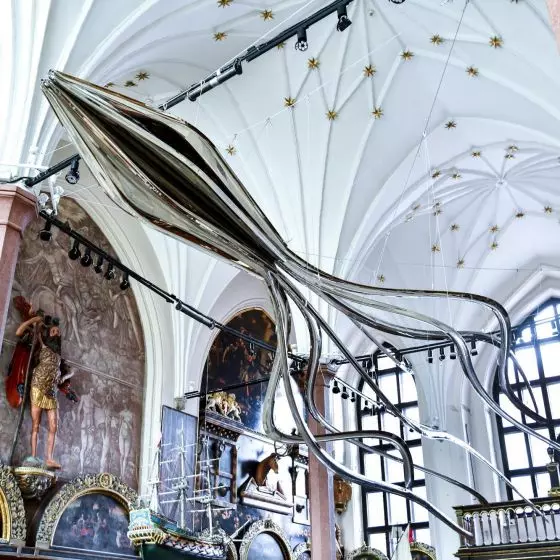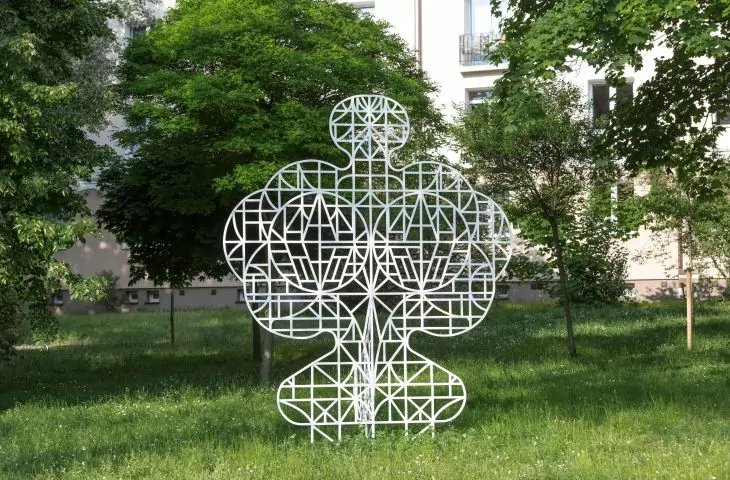Last year's Biennale of Design and Urban Art in Gdynia ran in a different form than previously planned due to the pandemic. One element of the program was the design and construction of sculptures in public spaces. The organizers cited old neighborhood playgrounds and their, often made of metal, equipment as inspiration. This gave rise to the idea of backyard forms. Now, after almost a year, two realizations can be seen in the Wzgórze Świętego Maksymiliana neighborhood.
The Biennale of Design and Urban Art is an event that combines artistic and design activities in urban spaces with a program of meetings, film screenings and debates on the urban contexts of architecture, art and community. In 2020, it moved its activities from Downtown to the St. Maximilian Hill neighborhood.
The 2020 Biennale, like almost all of this year's events around the world, went differently than we expected. The slogan we planned for the first edition implemented outside the Downtown was to be: "Come and see what's happening in your backyard." Meanwhile, it was made obsolete in March by #stayathome. Nevertheless, measuring ourselves against the challenges of the pandemic period, we realized six projects inscribed in and derived from public space, says Natalia Wielebska of Traffic Design
The artists were inspired by old elements that were equipment of playgrounds and backyards
© Traffic Design
backyard forms
As part of the biennial, Traffic Design announced a closed competition to which it invited visual artists to prepare proposals for backyard forms based on a brief description. The starting point for the projects was to be elements that used to be playground equipment - metal elephants, giraffes, trains built from tubes were a kind of artistic objects for play. Similarly, having a simple, geometric form, the arbor, which in addition to the function contained in the name, was a place for children to meet and play.
Of the submitted works, two were selected and realized: "Stolemka" by Stach Szumski and "Mist Maker" by Cekas. Both sculptures recently stood in the St. Maximilian Hill neighborhood.
Stolemka is inspired by Kashubian legends about giants
Photo: Rafał Kołsut © Traffic Design
from kashubia to gdynia's backyard
Extraordinary height, superhuman strength and many folk tales - Stolems are one of the most popular Kashubian legends. Now the spirit of the giants has arrived in Gdynia's backyard on Hallera Street. "Stolemka" by Stach Szumski, a young visual artist from Warsaw, a graduate of the Academy of Fine Arts in the capital, refers to the backyard climate and Kashubian legends, and its openwork construction inscribes it into the surroundings. The two-meter sculpture , which resembles a superhuman-sized woman, is made of metal. The drawing created by the artist, which, in a spray-painted version on canvas, could be seen during the exhibition "Fun with Context" accompanying the biennale, was adapted to a spatial form by Traffic Design.
The openwork form of "Stolemka"
photo: Rafał Kołsut © Traffic Design
radiator, or fog comber
"Fogcomber" is an abstract form referring to Salcia Halas ' short story "Fog," which was also one of the biennial realizations. The dense short story, heavily infused with local legends and the character of the neighborhood, was the starting point for the other artists. A sculpture by Lukasz Berger, operating under the pseudonym Cekas - an artist from Wroclaw who works on the borderline between installation, sculpture and street art - stood in the place where the pocket park is soon to be realized. Gdynia residents, who discussed the object on social media, called it a radiator. "It immediately got warmer!" - were written in the comments.
"Mist comber" refers to a short story by author Salcia Halas
Photo: Rafał Kołsut © Traffic Design
Abstract objects created in public space are not always easily accepted. Besides, we like to look in non-representational objects for associations with faces, animals or everyday objects. The objects that were created as part of the Elblag Sculpture Biennale work in a similar way. We hope that the "Mist Bohemian", "Stolemka" and the neon sign located in the neighborhood will become elements that reflect and build the identity of the district," Natalia Wielebska concludes.




































